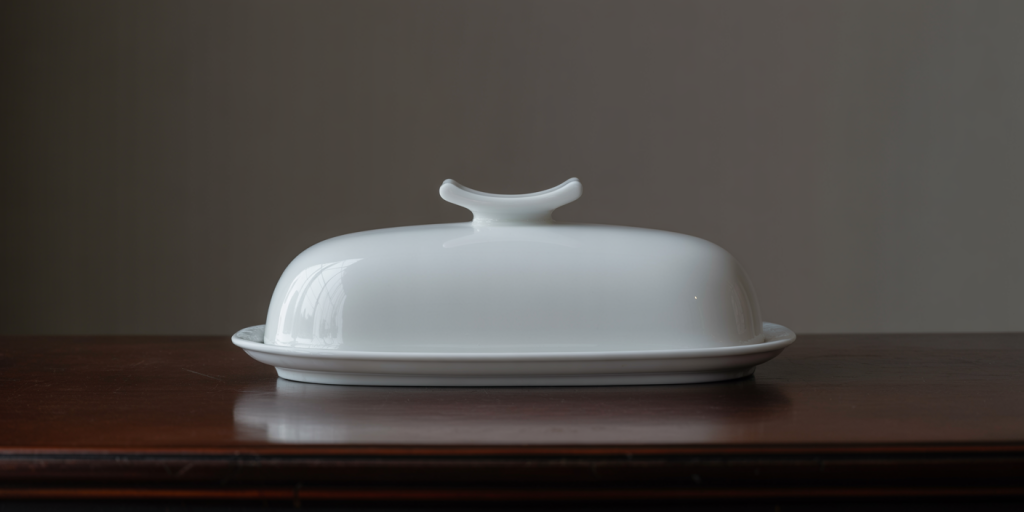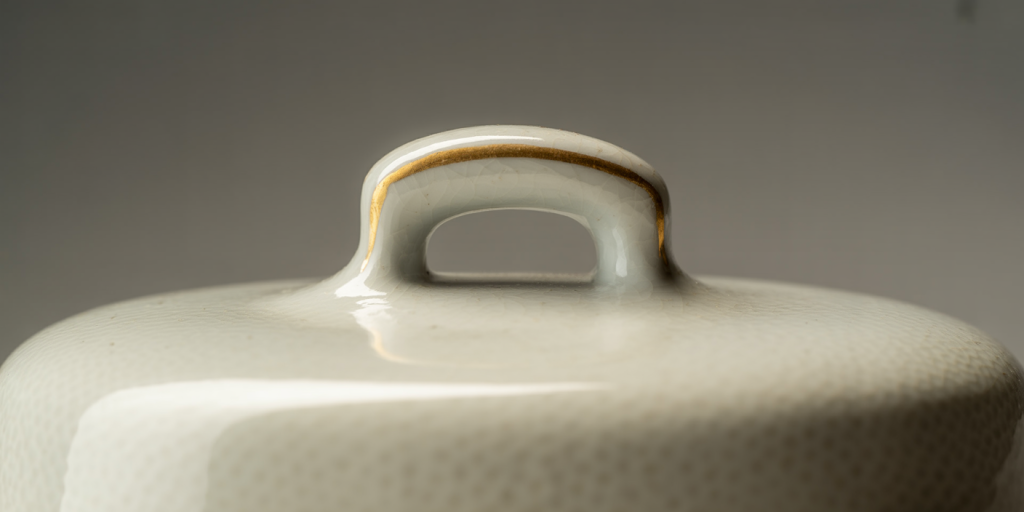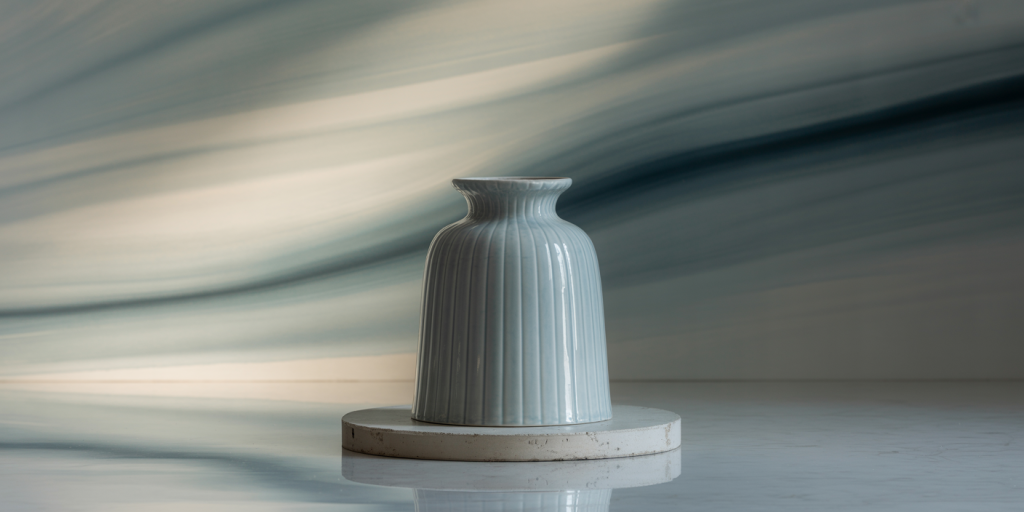William Nicholson and the Quiet Glow of the Butter Dish
A Contemplative Opening
It stands alone — modest, luminous, utterly still. A butter dish. But in the hands of William Nicholson, it is no longer a domestic object. It becomes a vessel of silence, an altar to light, a whisper in porcelain. This is not a portrait of butter. It is a portrait of restraint, of glimmering dignity, of the reverent hush that hovers over well-kept things.
Within the golden sheen of a mundane object, Nicholson finds grandeur. He does not chase myth or motion, but remains rooted in the hush of interiors, in the glint of morning light on glazed surfaces. His butter dish is not metaphor dressed as oil paint — it is metaphor made incarnate. It glows not with symbolism imposed, but with a quiet that is its own.
Table of Contents
- The Echo of Stillness in Glazed White
- A Light That Knows Where to Rest
- The Modesty of Majesty
- The Composition of Calm
- Porcelain as Prayer
- Where Butter Becomes a Soul
- Reflections That Do Not Lie
- The Architecture of Restraint
- The Silence Between Brushstrokes
- A Color that Refuses to Shout
- Weight, Air, and the Table Beneath
- Shadows that Caress Instead of Hide
- The Geometry of Grace
- Butter as Beacon, Dish as Shrine
- A Masterclass in Contained Emotion
- The Hand That Honored Humility
- The Domestic Sublime
- The Immobility of Eternity
- The Painting That Breathes in Whisper
The Echo of Stillness in Glazed White
The butter dish gleams, but softly. Its white is not the white of sterility, but of calm breath — the pause before a thought is spoken. Nicholson chooses not to animate the object but to let its stillness resonate outward, like the ringing of porcelain struck gently with time.
Here, stillness becomes language. Every gleam and absence speaks. And we, the viewers, must lean in not to decode, but to listen.
A Light That Knows Where to Rest
Light is the true protagonist in this composition. It drapes itself across the dish like a silken robe, catching on the lid’s edge, tracing the curve of the dome with delicate reverence. There is no flamboyance in this illumination. It does not boast — it blesses.
Nicholson does not invent light; he invites it. He coaxes it from the canvas with soft transitions, as if his brush had air instead of bristles.

The Modesty of Majesty
There is nobility in this butter dish — not aristocratic grandeur, but the nobility of function, of form perfected through simplicity. The object does not ask to be looked at, but quietly deserves it. It wears its whiteness like a robe of humility.
Nicholson elevates the humble not by embellishment, but by reverence. The majesty here lies not in drama, but in devotion.
The Composition of Calm
The butter dish is centered, but not obsessively so. It owns the canvas like a monk owns his robe — without pride, but with presence. The surrounding space is as important as the object itself, offering breathing room, solitude, serenity.
Every inch of the canvas is tuned toward stillness. The table, dark and flat, anchors the object. The background, unspoken, suggests timeless quiet.
Porcelain as Prayer
The surface of the dish is not merely smooth — it glows with a devotional finish. Nicholson paints porcelain not as mere material, but as sacred texture. It is cool, rounded, perfect in its purpose.
Touch is almost evoked — one can imagine the fingertip sliding over the glaze, meeting no resistance. Porcelain becomes skin. Or perhaps, spirit.
Where Butter Becomes a Soul
Though unseen inside the dish, the butter exists — and we feel it. It becomes a suggestion, a warmth hidden within restraint. The painting is about the promise of sustenance, not its consumption.
Nicholson does not show what we expect — he hints. And in that, butter becomes soul: hidden, essential, never ornamental.
Reflections That Do Not Lie
The light reflecting off the butter dish is honest. There are no exaggerated sparkles, no illusionistic tricks. The highlights are faithful to the object’s curves — a candor that makes the scene more intimate.
These reflections breathe. They speak softly of windows beyond, of a world outside this table that Nicholson chose not to show — and yet let in, through gleam.
The Architecture of Restraint
Nothing in this composition is excess. Not a brushstroke wasted, not a flourish indulged. Nicholson builds his world the way a haiku is written — with brevity, with care, with breath.
This architecture is not baroque but Zen. The butter dish sits not on a canvas, but within a temple of restraint.
The Silence Between Brushstrokes
One does not see Nicholson’s hand. His strokes do not draw attention to themselves. But one feels them — in the grace of transitions, in the gentle hum of paint meeting canvas.
His brushstrokes are the spaces between words in a poem. They give meaning not through presence, but through pause.
A Color that Refuses to Shout
White dominates, but it is not a shout. It is a hush layered upon hush: ivory, pearl, bone, cloud. Nicholson sculpts this white not with highlights, but with sympathy.
This is not a color that wants to be noticed — it wants to be understood. And it waits, patiently, for the viewer to grow quiet enough to hear it.

Weight, Air, and the Table Beneath
The dish has weight, yes — but it seems to hover just slightly above the wood, as if made less dense by its purity. The table, dark and silent, supports it not only physically but emotionally — like a note held beneath a melody.
Nicholson’s treatment of space and mass is masterful. The butter dish is not merely on the table — it converses with it.
Shadows that Caress Instead of Hide
The shadows cast are long, velvety, and merciful. They do not conceal. They cradle. They suggest the passing of afternoon, the curve of time as it settles gently into quietude.
These shadows become cushions. They give the butter dish a bed of dusk to rest upon.
The Geometry of Grace
Circles, domes, and symmetry: the form of the dish is inherently geometric. Yet in Nicholson’s hands, this geometry becomes grace. There is nothing mechanical in these arcs — only music.
The line where lid meets base is drawn with such elegance that it feels like the curve of a swan’s neck — precise, serene, intimate.
Butter as Beacon, Dish as Shrine
What lies inside the dish — ordinary butter — becomes, in this context, sacred. The dish is a reliquary. It holds not relics, but routine. And that routine is luminous.
Nicholson honors not the exotic, but the known. His reverence turns domesticity into cathedral.
A Masterclass in Contained Emotion
There is no figure here. No face, no gesture. And yet — this painting feels full. Full of emotion held in check, like tears not yet cried, like a sigh waiting to be released.
This is not a sentimental painting. It is an emotional one — because it respects silence as much as feeling.
The Hand That Honored Humility
Nicholson’s own hand, invisible but present, feels humble. He does not impose meaning. He witnesses. He records. He lets the dish be exactly what it is — and in doing so, lets it become more.
This humility is rare. It allows the painting to live beyond the canvas, to breathe in the viewer’s memory.

The Domestic Sublime
Nicholson’s butter dish exists in that rare category of the domestic sublime — the exaltation of the everyday into something eternal. It speaks not through grandeur but through gentleness.
This is the kind of painting that elevates our gaze — not upward, but inward. It reminds us that beauty begins on the breakfast table.
The Immobility of Eternity
The object does not move. It never will. But its stillness carries the breath of decades, of a quiet morning forever suspended in oil. It is eternity, made ordinary.
Nicholson paints not time, but its absence. The butter dish will never be opened. And thus, it will never decay.
The Painting That Breathes in Whisper
Some paintings roar. This one whispers. And the whisper lingers long after the eye has turned away. It becomes a presence — an invocation of grace in silence.
To stand before this work is to feel time slow. It is to remember that in the smallest things, the world waits to reveal itself.
FAQ
Who was William Nicholson?
Sir William Nicholson (1872–1949) was a British painter, illustrator, and printmaker known for his elegant still lifes, portraits, and woodcuts. His early training in graphic art informed his economy of form and his sensitivity to light.
When did he paint “The Butter Dish”?
Nicholson painted several still lifes featuring butter dishes and domestic objects in the early 20th century, particularly around 1910–1920. These works exemplify his minimalist yet expressive approach to everyday subjects.
What artistic style does Nicholson belong to?
Nicholson is associated with British Realism, but his work also draws from Impressionism and Japanese printmaking, especially in his focus on simplicity, negative space, and light.
Why is the butter dish important?
In Nicholson’s hands, the butter dish becomes more than a utilitarian object. It becomes a vessel for light, silence, and the spiritual dimension of domestic life.
Where can I see this painting?
Some of Nicholson’s still lifes are held in collections such as the Tate Britain, the Fitzwilliam Museum, and various private collections in the UK.
In the Gentle Light of the Everyday
There are no myths here. No gods, no heroines, no battle or bloom. Only porcelain. Only a surface that gleams beneath a slanted beam of light. And in that modest shimmer, William Nicholson captures eternity.
In the butter dish, we see not butter — but balance. Not nourishment — but stillness. And in that stillness, we are nourished.
